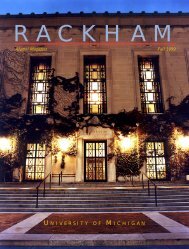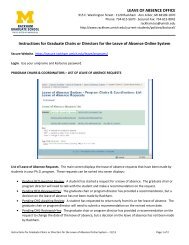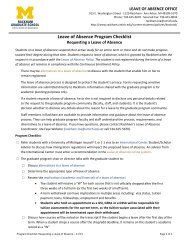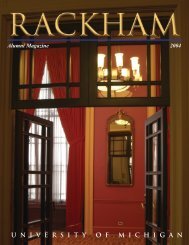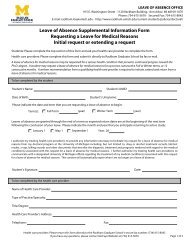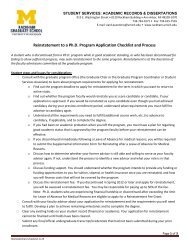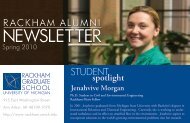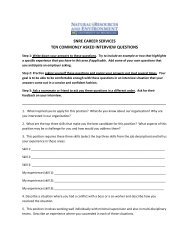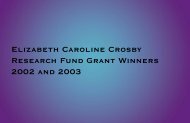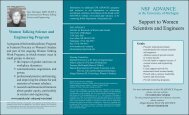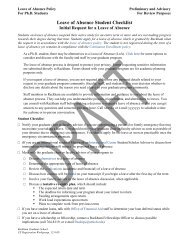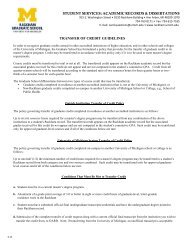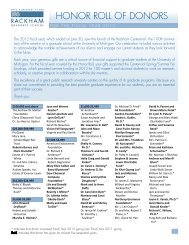Alumni Magazine 2001-2002 UNIVERSITYOFMICHIGAN - Rackham ...
Alumni Magazine 2001-2002 UNIVERSITYOFMICHIGAN - Rackham ...
Alumni Magazine 2001-2002 UNIVERSITYOFMICHIGAN - Rackham ...
You also want an ePaper? Increase the reach of your titles
YUMPU automatically turns print PDFs into web optimized ePapers that Google loves.
<strong>Alumni</strong> <strong>Magazine</strong> <strong>2001</strong>-<strong>2002</strong><br />
U n i v e r s i t y o f M i c h i g a n
CONTENTS<br />
From Research into Reality 2<br />
<strong>Alumni</strong> <strong>Magazine</strong><br />
Photo by Bill Wood<br />
The Countess 3<br />
Published annually by the Horace H. <strong>Rackham</strong><br />
School of Graduate Studies<br />
Earl Lewis<br />
Vice Provost for Academic Affairs-Graduate Studies and<br />
Dean, Horace H. <strong>Rackham</strong> School of Graduate Studies<br />
Jill McDonough<br />
Assistant to the Dean for Development and External Relations<br />
Kathryn D. Holmes<br />
Senior Development Officer<br />
Editor: Elyse Rubin<br />
Writer: Jeffrey Mortimer<br />
Designer: Rose Anderson<br />
Cover Photo: Bill Wood<br />
Contributing Photographers:<br />
Lin Goings, Peter Pagnotta, Sheila Ryan,<br />
Virginia G. Schendler, Bill Wood<br />
<strong>Rackham</strong> <strong>Alumni</strong> <strong>Magazine</strong> welcomes your comments.<br />
Please send correspondence to Elyse Rubin, Editor<br />
915 East Washington Street, Ann Arbor, Michigan 48109-1070<br />
or e-mail: elyserbu@umich.edu<br />
<strong>Rackham</strong> Executive Board<br />
Earl Lewis, Chair, <strong>Rackham</strong> Graduate School<br />
Vice Provost for Academic Affairs - Graduate Studies,<br />
and Dean of the Graduate School<br />
Phoebe Ellsworth, Professor, Psychology<br />
David Engelke, Professor, Biological Chemistry<br />
Caroline Gaither, Associate Professor, College of Pharmacy<br />
Richard I. Hume, Professor, Molecular, Cellular and<br />
Developmental Biology<br />
Susan Juster, Associate Professor, History<br />
Vahid Lotfi, Professor, School of Management - Flint<br />
Bruce Mannheim, Associate Professor, Anthropology<br />
Ronald Marx, Professor, School of Education<br />
Charlotte Otto, Professor, Natural Sciences - Dearborn<br />
James Porter, Professor, Classical Studies<br />
Phillip Savage, Professor, Chemical Engineering<br />
Louise Stein, Professor, School of Music<br />
Michael Thouless, Professor, Mechanical Engineering<br />
and Applied Mechanics<br />
Lynn Walter, Professor, Geological Sciences<br />
Jean Wineman, Professor, School of Architecture and Urban Planning<br />
<strong>Rackham</strong> Board of Governors<br />
Lee C. Bollinger, Chairman; President, University of Michigan<br />
Earl Lewis, Secretary; Dean, Horace H. <strong>Rackham</strong> School<br />
of Graduate Studies<br />
Billy E. Frye, Chancellor, Emory University<br />
Roberta W. Gutman, Corporate Vice President and<br />
Director of Global Diversity, Motorola<br />
Melvin Oliver, Vice President for Asset Building and<br />
Community Development Program, The Ford Foundation<br />
Renaissance Man 4<br />
More than Meets the Ear 5<br />
Empowering Healthy Neighborhoods 6<br />
Algorithms for Better Living 7<br />
Archiving Books and Bytes 8<br />
Service with a Smile 9<br />
Advocating for Access 10<br />
Workforce Wizard 11<br />
Nature’s Negotiator 12
From the<br />
Dean<br />
Welcome to the third annual issue of the <strong>Rackham</strong> <strong>Alumni</strong><br />
<strong>Magazine</strong>, and thank you for spending some of your<br />
time with us. Our theme this year might be expressed as<br />
“The Value of Academic Training Outside Academia,” and it goes<br />
right to the heart of the current national debate about the need to<br />
reform graduate education. There have been several reports over the<br />
last decade or so that it takes too long, that it’s too expensive, that<br />
it’s too narrow. However, when we do our job well, we train people<br />
to become leaders, in whatever professional milieus they choose.<br />
Here you will be introduced to several alumni and current students,<br />
including Ingrid Sheldon, a former teacher who served four<br />
terms as Mayor of Ann Arbor; David Wu, an accomplished musician<br />
and graphic designer whose research focus is the retina;<br />
Heather Wathington, who is parlaying her academic interests and<br />
corporate experience into building support for the loftiest goals of<br />
higher education; and Ted Tyler, whose activities on behalf of social<br />
justice have paralleled his successful business career.<br />
Corporations, government, and nonprofit agencies, as well as<br />
academe, need people who are trained as linguists, social anthropologists,<br />
literary critics, and historians. Quite honestly, there still<br />
remains a tension inside of the academy. It has required a great<br />
degree of soul-searching to say that if the only thing we’re doing is<br />
training faculty, we have missed the opportunity to truly educate<br />
beyond the baccalaureate level. Our mission is at least twofold: not<br />
only to reproduce the next generation of university and college faculty,<br />
but also to reproduce the next generation of social leaders, no<br />
matter where they work.<br />
Students have many different interests. It’s a disservice to try to<br />
shoehorn them into following one, when what we should do is provide<br />
them at an early stage with the means to learn that they can do<br />
many things, and probably will. Those who pursue multiple careers,<br />
inside and outside the academy, will tell you they are constantly<br />
Photo by Lin Goings<br />
learning. The completion of a degree is not the end but, in some<br />
sense, the beginning of the learning process.<br />
Those of us who are in mainline academic appointments must begin to realize we need more and more involvement with those<br />
who are not. This is a symbiotic relationship. In engineering, a good proportion of the new faculty that we have hired in recent years<br />
have come from research labs and industry. The same thing is true of the growth in the number of clinical professors both in law and<br />
in medicine.<br />
In recent years, the idea of learning for the sake of learning has been diminished, if not discouraged. The people profiled in this<br />
magazine are ambassadors for the notion that there is indeed an intrinsic value to learning. Although sometimes specialized and even<br />
esoteric, learning — in and of itself — is part of the process that equipped them to respond to the many challenges presented to them<br />
over a lifetime.<br />
A final word about <strong>Rackham</strong>. In the last few months, we have all reexamined our values and our priorities. What has emerged<br />
from this period of reflection is the inspiring determination of our students to move forward, to complete their degrees, and to<br />
use their considerable talents for the good of the larger world. Their work has just begun and carries with it the promise of a<br />
brighter future.<br />
Best Regards,<br />
Earl Lewis
S T U D E N T P R O F I L E S<br />
2<br />
Photo by Bill Wood<br />
From Research<br />
into Reality<br />
“Public Policy means more than ‘How do<br />
we solve this particular problem’ ”<br />
Susan Moffitt found out early how<br />
challenging it can be to stand in<br />
front of a classroom. As an<br />
American teenager attending private<br />
school in France while her father<br />
worked there, she was assigned to<br />
teach the week reserved for the study<br />
of U.S. history.<br />
“I prepared, I prepared, I prepared,”<br />
she says. “The three branches of<br />
government, major presidencies,<br />
major wars, then I did my little intro<br />
and opened up the floor for questions<br />
and the first one I got was on Al<br />
Capone, of all things. That was my<br />
introduction to teaching. You think<br />
you can answer all the questions, but<br />
the truth is there’s always a curveball.”<br />
Her career since then shows that<br />
Moffitt was clearly undaunted. A doctoral<br />
candidate in political science at<br />
Michigan, she pursues answers in her<br />
research with the same zeal she brings<br />
to bridging disciplines and teaching<br />
classes.<br />
While a graduate student at U-M’s<br />
Institute of Public Policy Studies, she<br />
met David K. Cohen,<br />
John Dewey Collegiate<br />
Professor of<br />
Education and<br />
Professor of Public<br />
Policy. “He proposed<br />
that, after I finished<br />
my master’s degree,<br />
I come on as a fulltime<br />
research associate<br />
in the School<br />
of Education and<br />
we could write a<br />
book together on<br />
Title I, the largest<br />
federal education<br />
program,”<br />
Moffitt recalls.<br />
Enacted in 1965<br />
as part of<br />
President<br />
Lyndon<br />
Johnson’s War<br />
on Poverty,<br />
it’s now<br />
found in 95<br />
percent of all<br />
school districts.<br />
Its<br />
ubiquity<br />
was at least<br />
as appealing as the light it<br />
sheds on public education issues.<br />
“Title I is a very nice window into<br />
broader education problems,” she<br />
says. “It illuminates the problem of<br />
implementing public policy when it’s<br />
created at one level and expected to be<br />
enacted at another level. The goals<br />
that schools are expected to achieve<br />
have grown dramatically, and our<br />
book is about what kind of resources<br />
we would actually have to have in<br />
place to be able to meet these very<br />
ambitious goals.” In two words,<br />
“more” and “better.” Says Moffitt:<br />
“We argue that knowledge and ideas<br />
can play a significant role in the formation<br />
and re-formation of policy, and<br />
in implementation. Developing knowledge<br />
about school improvement and<br />
the capacity to help schools improve<br />
are vital to implementing ambitious<br />
school reform.”<br />
Researching the book convinced<br />
her that she needed a PhD. “I wanted<br />
to get a little more theoretical grounding,<br />
a little more quantitative training,<br />
and I also wanted to be able to teach<br />
and have my own research agenda in<br />
public policy,” she says. “I always<br />
want to make sure my work has realworld<br />
implications or is connected<br />
with salient public policy problems.”<br />
That, and the fact that her husband is<br />
an aerospace engineer in not-so-distant<br />
Dayton, Ohio, helped her choose<br />
Michigan. “It’s a fabulous department,<br />
especially for someone whose interests<br />
are applied as well as theoretical,”<br />
she says. “In American government,<br />
Michigan just trumps everybody.”<br />
Her dissertation examines public<br />
participation in federal agency<br />
policymaking, clearly wedding her<br />
theoretical and practical concerns.<br />
“I’m looking at how expertise is a<br />
political resource for agencies, and<br />
how they use their public advisory<br />
committees’ expertise to help them<br />
manage their political environment,”<br />
says Moffitt. “When I have my policy<br />
hat on, I think about how this matters<br />
to drug approval, how this bears on<br />
student financial aid or on the collection<br />
of education statistics. The political<br />
science part makes me think of<br />
what this means for democracy, how<br />
can it speak to our democratic institutions.<br />
And that’s useful. Public policy<br />
means more than ‘How do we solve<br />
this particular problem’ ”<br />
In a sense, public policy also<br />
includes working with youth groups,<br />
volunteering for public radio and local<br />
election boards, and participating in<br />
the Vice President’s Performance<br />
Review Task Force, all of which<br />
Moffitt has done. “I found when I was<br />
a graduate student instructor that students<br />
appreciated it when I could<br />
bring our discussion back to personal<br />
stories, whether it was about working<br />
on the National Performance Review<br />
Task Force or showing them what<br />
campaign propaganda actually looks<br />
like,” she says. “Getting my hands<br />
into applied politics a little bit helped<br />
make me a better teacher.”<br />
Pedagogy – her own – is a key tile<br />
in Moffitt’s life mosaic. “Given the<br />
range of paths I could pursue, I find<br />
academia compelling because it<br />
allows me both to conduct rigorous<br />
research that bears on important social<br />
and political issues, and to equip others<br />
with knowledge and tools to participate<br />
in policymaking,” she says.<br />
“Neither teaching nor research alone<br />
would fulfill what I see as a twofold<br />
responsibility.” ■
always been interested in<br />
numbers that shed light on<br />
“I’ve<br />
social issues,” says Joann<br />
Vanek, the woman who designed and<br />
conducted global statistics programs<br />
for the United Nations for more than<br />
20 years. “The world today runs on<br />
numbers and people want numbers,<br />
but often they don’t know how, or<br />
don’t want to take the time, to do the<br />
work that’s necessary to use numbers<br />
appropriately. It’s hard work. And it’s<br />
not very glamorous.”<br />
When she started graduate school<br />
in 1963, she wasn’t particularly<br />
focused on either gender issues or statistics.<br />
Decades later, she has emerged<br />
as a pioneer in the nascent field of<br />
gender statistics, and her career since<br />
has significantly influenced the way<br />
the world’s governments think about,<br />
and use, social data.<br />
“When I came to Michigan, I had<br />
more of an historical interest,” she<br />
recalls, “but at Michigan, you can’t<br />
help but take up statistics, and the<br />
quantitative nature of that training is<br />
what sensitized me to the importance<br />
of numbers. It gave me an understanding<br />
of data, how to put it together,<br />
how to analyze it, and how to use it to<br />
make a statement about what is happening.”<br />
When Vanek began conceptualizing<br />
and preparing the first issue of The<br />
World’s Women: Trends and Statistics,<br />
she had to work hard through three<br />
important steps. “First of all,” she<br />
says, “the data had to be put together<br />
in a way that was usable to non-statisticians.<br />
Let’s say someone wanted to<br />
compare the status of women in countries<br />
around the world — on indicators<br />
such as employment, education,<br />
life expectancy. The data to do this<br />
were collected by different authorities,<br />
so we had to take all these data<br />
from different sources and put them<br />
together in a way that people would<br />
have access to them, and they could<br />
be used to describe what is happening.”<br />
“A second problem is that national<br />
statistical systems had been set up in a<br />
way that didn’t reflect gender issues.<br />
The work that women do is often not<br />
well measured, and often health statis-<br />
The Countess<br />
tics aren’t disaggregated by sex. A<br />
third issue is because you’re dealing<br />
with national statistics, you<br />
have to know a lot of the conventions<br />
and the methods used to collect<br />
data to use them correctly.”<br />
Such meticulous work paid off.<br />
Since its first issue in 1991 (the<br />
third came out in 2000), The<br />
World’s Women has become the<br />
UN Secretariat’s best-selling<br />
research publication, a recognized<br />
authority as well as a template for<br />
cognate statistical compendiums.<br />
“Previous UN publications in statistics<br />
hadn’t really analyzed statistics,”<br />
she says, “but this one’s<br />
first sentence was ‘Words advocating<br />
the interests of women,<br />
however plausible and persuasive<br />
they may be, need numbers to<br />
influence policy — and change<br />
the world.’ That was a monumental<br />
statement for a UN Statistics Division<br />
publication.”<br />
“The world today runs on<br />
numbers and people want<br />
numbers, but often they don’t<br />
know how, or don’t want to<br />
take the time, to do the work<br />
that’s necessary to use numbers<br />
appropriately. It’s hard work.<br />
And it’s not very glamorous.”<br />
“At the same time, a woman in<br />
Sweden was doing a similar publication<br />
for her own country, and both of<br />
these publications have generated a<br />
great deal of interest and now inform<br />
the policy debate. They have been so<br />
popular that part of what we in the<br />
United Nations, the Swedish authorities<br />
and others have done is assist<br />
countries in developing such publications<br />
as well as to improve the underlying<br />
data on women.”<br />
Vanek’s dissertation, Time Spent in<br />
Housework, was a trailblazer, too. “I<br />
was interested in looking at lifestyle<br />
and leisure patterns, using a multinational<br />
time-use survey that had been<br />
Photo by Virginia Schendler<br />
collected across 13 countries,” she<br />
says. “I wasn’t interested in gender<br />
issues at that time. I analyzed the data<br />
in terms of leisure patterns, but the<br />
most dramatic findings related not to<br />
leisure but to housework.”<br />
After retiring from the UN earlier<br />
this year, she became co-director of<br />
the statistics program for Women in<br />
Informal Economy: Globalizing and<br />
Organizing (WIEGO), a worldwide<br />
coalition of grass-roots organizations,<br />
academic institutions and development<br />
agencies to support women<br />
workers in the informal sector.<br />
“There’s a movement to try to<br />
improve the conditions of these workers,”<br />
she says. “It so happens that<br />
most of them are women and they<br />
have no job security or social protection,<br />
very low wages and long working<br />
hours. Again, numbers are very<br />
important to show how numerous<br />
these workers are and to document<br />
their working conditions. That’s my<br />
role in it. Sometimes I’d be working<br />
on these reports and come across statistics<br />
that bring home the difficulties<br />
of the life of these people. We’re so<br />
removed from their life situation and<br />
yet the statistics push one to do<br />
more.” ■<br />
A L U M N I P R O F I L E S<br />
3
S T U D E N T P R O F I L E S<br />
4<br />
Photo by Bill Wood<br />
David Wu finds retinas beautiful.<br />
Also music, medicine and graphic<br />
design. Directly admitted to<br />
the University of Michigan Medical<br />
School from high school in Brighton,<br />
Michigan via the Inteflex program, he<br />
took three years of undergraduate and<br />
graduate courses, assisted on numerous<br />
research projects, and completed<br />
his first two years of medical school<br />
before taking a temporary leave of<br />
absence to pursue a PhD in<br />
Neuroscience.<br />
In his spare time, he plays the<br />
piano, carillon and clarinet. He helped<br />
organize and performs in the<br />
Alexander Borodin Society, a group of<br />
medical and graduate student musicians<br />
who play recitals in the UM hospital.<br />
He is one of the founders and<br />
serves on the executive committee and<br />
as principal clarinetist for the Life<br />
Sciences Orchestra (LSO), a full symphonic<br />
orchestra of 70 faculty, staff,<br />
and students from life sciences units<br />
around the university. He also does<br />
graphic design — he and his Mac<br />
have helped create brochures for student<br />
groups, student handbooks for<br />
the medical school and websites for<br />
the Neuroscience Graduate Program<br />
and Borodin Society. Most recently,<br />
he designed the logo, posters, concert<br />
programs, and website for the LSO.<br />
Wu believes the same aesthetics<br />
enjoyed in music and design are found<br />
in science. “It’s hard to study a complex<br />
system like the human body or<br />
the retina and not get an appreciation<br />
of how beautifully they are designed,”<br />
he says. “We’ll be studying things in<br />
the lab that make no sense, and<br />
inevitably, in a week or a year or 20<br />
years from now, someone will realize<br />
it was designed this way for a reason.<br />
The best examples of design are found<br />
in nature.”<br />
The research bug first bit Wu<br />
between his junior and senior years in<br />
high school. “Dr. Kenneth Balazovich,<br />
a UM scientist living in Brighton,<br />
came to our high school asking if any<br />
students were interested in hanging<br />
out in the lab,” he recalls. “His slogan<br />
was ‘come and see how research is<br />
really done.’ I spent a summer with<br />
him and, after that, I never wanted to<br />
leave the lab.”<br />
By his second year of medical<br />
school, that feeling was even more<br />
pronounced. In addition to his studies<br />
and his music, he had been researching<br />
retinal regeneration in the laboratory<br />
of Pamela Raymond, Professor of<br />
Cell and Developmental Biology. “I<br />
had worked on other projects, but this<br />
was the first time someone gave me<br />
free rein to figure out whatever I had<br />
to do to solve this problem,” he says.<br />
With only a few months left before<br />
the clinical phase of the MD curriculum<br />
began, he made his decision.<br />
“I realized I wasn’t ready to go to<br />
the hospital and give up my research<br />
project just yet. I met several<br />
<strong>Rackham</strong> students while in the lab,<br />
“It’s hard to study<br />
a complex system<br />
like the human<br />
body or the retina<br />
and not get an<br />
appreciation of<br />
how beautifully<br />
they are designed.”<br />
Renaissance Man<br />
and after interacting with them I realized<br />
that I wanted the scientific rigor<br />
and discipline that comes with getting<br />
a PhD. And I also realized that there<br />
are actually many ways to help people,<br />
and research is one way I want to<br />
help.”<br />
His current research in the W.K.<br />
Kellogg Eye Center lab of Dr. Donald<br />
Puro, Professor of Ophthalmology and<br />
Physiology, could help many – its<br />
focus is diabetic retinopathy, a leading<br />
cause of blindness in working-age<br />
Americans. “The retina is the neural<br />
tissue inside your eye that can sense<br />
light,” Wu explains. “Any tissue needs<br />
a blood supply to stay alive and function,<br />
and we are studying how that<br />
blood supply keeps retinal neurons<br />
happy. We think that retinal neurons<br />
may have ways of telling the retinal<br />
blood supply whether they are receiving<br />
enough oxygen and nutrients. In<br />
the retinas of patients with poorly<br />
controlled diabetes, the blood vessels<br />
don’t work well. They become very<br />
leaky, the neurons don’t get the nourishment<br />
they need, the retina eventually<br />
dies, and patients lose their vision.”<br />
Wu aspires to a life like Dr. Puro’s,<br />
who he says has “the best job in the<br />
world. He sees patients once a week.<br />
He does surgery once a week. The rest<br />
of the time, he’s in the lab, learning<br />
about basic mechanisms, trying to<br />
understand the design of nature.” ■
linguistics”<br />
sounds like some arcane<br />
“Discourse<br />
corner of academe, but her<br />
specialty actually reflects the breadth<br />
of Frances Trix’s perspective and<br />
experience.<br />
“Discourse is when you go above<br />
the level of a grammatical unit,” says<br />
Trix, who holds a bachelor’s and master’s<br />
in Near Eastern languages and<br />
literature and a master’s and PhD in<br />
linguistics — all from the University<br />
of Michigan — and is an Associate<br />
Professor of Anthropology at Wayne<br />
State University in Detroit. “You’re at<br />
a cultural unit. It has a social meaning.”<br />
That counts for a lot with Trix, who<br />
spent the decade after getting her first<br />
master’s degree teaching in a<br />
Lebanese village and running a bilingual<br />
program in Dearborn, Michigan,<br />
among other things, and who has seasoned<br />
her academic career since with<br />
her advocacy on behalf of oppressed<br />
minorities in the Balkans (the result of<br />
a year studying Albanian in Kosovo<br />
on a fellowship at the University of<br />
Prishtina) as well as consulting for the<br />
National Aeronautics and Space<br />
Administration.<br />
“… all interesting<br />
things in life come<br />
back to language.”<br />
Real life was a harsh teacher in<br />
Kosovo. “The tension in daily life was<br />
something I had never experienced,”<br />
she says. “I got picked up by the<br />
secret police. I had all my mail read.<br />
For some people who know the communist<br />
world, it may have come easier,<br />
but I was naïve and unprepared, so<br />
I think the political aspects hit me<br />
more profoundly.”<br />
From 1968 until his death in 1995,<br />
Trix was a student of Baba Rexheb,<br />
the leader of a Sufi Muslim<br />
monastery in suburban Detroit, a relationship<br />
made possible in part because<br />
she spoke Turkish. “It’s not the average<br />
academic thing,” she says of her vita.<br />
Her regular visits to the monastery<br />
provided “a wonderful juxtaposition,”<br />
More than Meets<br />
Photo by Bill Wood<br />
the Ear<br />
says Trix. “With Baba, there was no<br />
syllabus, no exams. As in other spiritual<br />
traditions, you study with your<br />
teacher until your teacher passes on.<br />
Baba taught by the way he lived. With<br />
the university, you give lectures and<br />
write articles, it’s a little more secondhand,<br />
but I had this remarkable<br />
teacher throughout.”<br />
Trix synthesizes her academic<br />
knowledge and practical experience<br />
into her current work. “I get into<br />
interesting research at Wayne State<br />
because our anthropology department<br />
has a very strong applied component,”<br />
she says. “That’s how I got working<br />
for NASA. A graduate student in one<br />
of my seminars was working with a<br />
colleague of mine on analyzing close<br />
call data for the shuttle program. She<br />
asked me if I thought I could find<br />
subtle linguistic clues in the shuttle<br />
problem reports. I said, ‘I can always<br />
find subtle linguistic clues.’ I was<br />
being kind of offhand but, of course,<br />
all interesting things in life come back<br />
to language.” ■<br />
A L U M N I P R O F I L E S<br />
5
S T U D E N T P R O F I L E S<br />
6<br />
Photo by Bill Wood<br />
Shannon Zenk knew just what she<br />
wanted, and just where to find it.<br />
After receiving her bachelor’s<br />
degree in nursing from Illinois<br />
Wesleyan University, she worked for a<br />
year in a medical-surgical unit of a<br />
hospital, then for another year as a<br />
nurse case manager in home health<br />
care before earning master’s degrees<br />
in Nursing and Public Health from the<br />
University of Illinois-Chicago.<br />
“I think I recognized that influences<br />
on health were much bigger than the<br />
education I provided, such as what to<br />
eat or do for exercise,” Zenk says.<br />
“That just didn’t cut it. Structural factors<br />
like poverty and the neighborhood<br />
conditions under which people<br />
lived had a much greater impact. I<br />
wanted to understand better what<br />
those bigger factors were. It’s one<br />
thing to advise people to change their<br />
diet and exercise more; it’s another to<br />
make that possible for people.”<br />
It seemed clear to her that identifying<br />
the underlying structural factors<br />
and connecting them to people’s lives<br />
and health would require research, as<br />
well as critical input from community<br />
members themselves. The answer was<br />
community-based participatory<br />
research, in which community residents,<br />
organizational representatives,<br />
and academics work together to carry<br />
out research and interventions.<br />
It also seemed clear to her that the<br />
University of Michigan was the place<br />
to go for this. She’s currently working<br />
on two projects in the city of Detroit<br />
under the aegis of the Detroit<br />
Community-Academic Urban<br />
Research Center, a partnership<br />
between community-based organizations,<br />
health agencies, and the<br />
U-M Schools of Public Health and<br />
Nursing.<br />
“One of my goals when I came here<br />
was to learn how to work with community<br />
members and organizations in<br />
order to do this kind of research, how<br />
to form and sustain relationships, and<br />
draw on the strengths of all of the<br />
partners involved.”<br />
“There are a number of advantages<br />
to this approach,” she adds. “You<br />
build on strengths and resources that<br />
are already in the community instead<br />
of solely focusing on problems. And<br />
the information gathered is more<br />
locally relevant and useful when you<br />
engage people who live in and are<br />
knowledgeable about the community.”<br />
One of the projects she’s involved<br />
with is the East Side Village Health<br />
Worker Partnerships, an intervention<br />
project for which a five-year followup<br />
survey was just completed. “The<br />
aim of the project is to understand<br />
social factors that influence the health<br />
of women and families living on the<br />
east side of Detroit, as well as to conduct<br />
interventions to address these<br />
factors,” Zenk says. One purpose of<br />
the follow-up survey is to evaluate the<br />
“We define the environment very broadly.<br />
Do people have access to fresh fruits and<br />
vegetables Do they have access to safe<br />
places to exercise What stressors do they<br />
experience, such as lack of employment<br />
opportunities and discrimination”<br />
Empowering<br />
Healthy<br />
Neighborhoods<br />
intervention, which involves about<br />
40 lay health advisors from the<br />
community.<br />
The intervention component is crucial<br />
to Zenk, and to her passion for<br />
this kind of research. “The ultimate<br />
goal is to solve problems and improve<br />
people’s quality of life and their<br />
health.”<br />
If that means some walls between<br />
disciplines or between the academy<br />
and the community it works with have<br />
to come down, then so be it. Zenk<br />
sees her department, Health Behavior<br />
and Health Education, as “a way to<br />
blend social science and medical science.<br />
One of my interests and one of<br />
the interests of the department is how<br />
the environment, social and physical,<br />
shapes people’s health.”<br />
And, she says, “We define the environment<br />
very broadly. Do people have<br />
access to fresh fruits and vegetables<br />
Do they have access to safe places<br />
to exercise What stressors do they<br />
experience, such as lack of employment<br />
opportunities and discrimination”<br />
The ultimate goal is to make a difference<br />
that outlives the study.<br />
“Sustainability is an important part of<br />
this approach to research,” Zenk<br />
says. “As a partnership, we’re developing<br />
resources and relationships that<br />
will continue beyond the funding<br />
period and current projects.” ■
Photo by Sheila Ryan<br />
One of Milton Morris’ most<br />
memorable moments as a<br />
member of Northwestern<br />
University’s football team came<br />
against the University of Michigan, a<br />
33-yard pass reception when he was a<br />
freshman in 1988. In 1992, Michigan<br />
caught Morris — he earned his master’s<br />
and PhD in electrical engineering<br />
from U-M — and then Guidant<br />
Corporation of St. Paul, Minnesota,<br />
did the same. Fewer than four years<br />
after joining that company, one of the<br />
world’s leading makers of cardiac<br />
devices, Morris became its manager<br />
of tachycardia therapy research, in<br />
charge of designing and testing products<br />
that will add many moments to<br />
many lives.<br />
Where he’s at right now offers him<br />
the best of several worlds. He still<br />
does research, publishes articles and<br />
presents at professional conferences,<br />
although his research is usually, and<br />
understandably, targeted toward specific<br />
applications. He also returns to<br />
Ann Arbor periodically, both to recruit<br />
doctoral students for Guidant and as a<br />
member of the <strong>Rackham</strong> Dean’s<br />
Advisory Board, and he teaches courses<br />
at the University of Minnesota.<br />
Algorithms<br />
for Better Living<br />
“It’s not necessarily about saving<br />
lives but certainly improving<br />
the quality of life.”<br />
Multiple worlds are nothing new to<br />
Morris, although he says excelling<br />
both academically and athletically is<br />
not as rare as the conventional wisdom<br />
would have it. This is based not<br />
only on his own playing career, but<br />
also on the three years he spent tutoring<br />
athletes while he was in graduate<br />
school, the last two focused on football<br />
players.<br />
“The college athlete probably gets a<br />
bum rap,” he says. “There are a lot of<br />
really bright guys on the football team<br />
and I’m not sure people are aware of<br />
that or care to acknowledge it. I am<br />
still familiar with the pain and struggle<br />
associated with undergraduate<br />
football and engineering.”<br />
The loop he’s in now has been dominated<br />
by spearheading improvements<br />
to the implantable cardioverter defibrillator<br />
(ICD), the most recent addition<br />
to Vice President Cheney’s internal<br />
hardware. “Guidant is a major<br />
manufacturer of that device, although<br />
his comes from the competition,” says<br />
Morris, “but he does have one of our<br />
stents!”<br />
The ICD addresses irregularities in<br />
the heartbeat that can render victims<br />
fatigued and dizzy. “It’s not necessarily<br />
about saving lives but certainly<br />
improving the quality of life,” he says.<br />
“A major thrust of what I’ve been<br />
doing here for the last three years or<br />
so is designing the algorithms that<br />
allow the device to detect an atrial<br />
arrhythmia from a ventricular arrhythmia<br />
and also to evaluate the actual<br />
therapies and the diagnostics that this<br />
device would provide. I actually came<br />
up with some of the algorithms, tested<br />
those algorithms and transferred them<br />
over to the design teams, set up some<br />
clinical studies in Europe and Asia to<br />
look at therapies for atrial fibrillation,<br />
and did a whole host of other miscellaneous<br />
things to help the design<br />
teams alter their device.”<br />
Morris never dreamed of a career in<br />
medical science when he started graduate<br />
school as a signal processing<br />
major, but it just happened that the<br />
signal he was processing was a biological<br />
one. “That required me to<br />
learn about biophysics, physiology<br />
and in particular cardiac electrophysiology,”<br />
he recalls. “I found the material<br />
that I was being taught really compelling<br />
and very interesting. It struck<br />
a chord with me and I haven’t looked<br />
back since.” ■ 7<br />
A L U M N I P R O F I L E S
S T U D E N T P R O F I L E S<br />
8<br />
Archiving Books<br />
and Bytes<br />
is good,” says<br />
Christopher Frey. “We<br />
“Paper<br />
know it works.”<br />
Then he quotes computer scientist<br />
Jeff Rothenberg: “Digital information<br />
lasts forever or five years, whichever<br />
comes first.” But Frey is no Luddite.<br />
He received his Master of Science<br />
Information in Archives and Record<br />
Management from the University of<br />
Michigan School of Information in<br />
August, already has considerable<br />
experience in working with digital and<br />
paper documents, and envisions that,<br />
at least initially, as a career path.<br />
On the other hand, he came to<br />
information science via the path of<br />
history. His bachelor’s is in Medieval<br />
and Renaissance<br />
Studies and he once<br />
contemplated a<br />
career in teaching.<br />
“I wanted a field<br />
whose purpose is to<br />
show that history is<br />
relevant,” he says.<br />
“One summer, I got<br />
a part-time job at<br />
the Bentley<br />
Historical Library, about”<br />
and I said, ‘Wow, I<br />
really like this archives thing,’ so I<br />
“Privacy and free<br />
access are both<br />
great things, but<br />
which are we<br />
more concerned<br />
came back the next summer. They said<br />
if I really liked archives, I should go<br />
to the premier archives program, and<br />
that’s how I got into the School of<br />
Information.”<br />
Thus, he’s well aware not only of<br />
paper’s virtues and limitations, but<br />
also of the hegemony of the contents<br />
of all those documents, regardless of<br />
how, or on what, they’re stored and<br />
distributed.<br />
“I have tremendous respect for the<br />
original documents and the authority<br />
of the documents,” he says, “but some<br />
days I feel like if the warehouse<br />
caught on fire, it would just be a lot<br />
less work for me.” Electronic documents<br />
are an answer to the weight and<br />
space problems that paper presents,<br />
but what about durability And<br />
privacy<br />
“My interest<br />
in government<br />
records<br />
specifically is<br />
that these are<br />
documents<br />
that are<br />
meant to be<br />
seen,” he<br />
says. “This is<br />
your government<br />
at work,<br />
these are your tax dollars, these<br />
shouldn’t be hidden in a box. But<br />
there are also consequences for when<br />
this information is easily available. It<br />
used to take a very determined<br />
researcher to find out a lot of personal<br />
information. When someone<br />
can just turn on their<br />
computer and go click,<br />
click, click, there’s a whole<br />
different set of implications.<br />
Privacy and free<br />
access are both great<br />
things, but which are we<br />
more concerned about”<br />
Information science<br />
seems to be an arena where<br />
not only does history converge<br />
with technology, but<br />
a whole host of such complex questions<br />
also meet, if not collide.<br />
“One of the most exciting things<br />
about the field is that with every issue<br />
that comes up, there are all these balances<br />
you have to strike,” Frey says.<br />
Fortunately, he feels his training has<br />
prepared him well.<br />
“The School of Information is really<br />
interdisciplinary,” he says. “I came<br />
in from the humanities angle and I<br />
had to learn a lot more about computers<br />
than I did before. If I’m going to<br />
be putting information on line, I can’t<br />
just think about the documents and the<br />
history, but how to make them accessible<br />
in a meaningful and usable way.<br />
The concept of usability and user testing<br />
is really big at SI.”<br />
Frey spent two months in the summer<br />
of 2000 with a team of fellow SI<br />
Photo by Bill Wood<br />
students at the University of Fort Hare<br />
in South Africa, where he learned<br />
about a whole new universe of difficulties.<br />
“My colleagues went on this<br />
road trip to check out some schools<br />
that were looking into the possibilities<br />
for distance education in some very<br />
rural areas. They didn’t even have<br />
electricity or a phone line, much less a<br />
computer.”<br />
The University of Fort Hare itself is<br />
somewhat of a relic from the days of<br />
apartheid; it was the first, and for<br />
many years the only, college in South<br />
Africa to admit blacks. But this also<br />
made it the alma mater of Nelson<br />
Mandela and many other prominent<br />
black leaders in the country, including<br />
the father of the incumbent president.<br />
In addition, some of the African<br />
National Congress’ archives are<br />
housed there. The government, Frey<br />
says, seems ambivalent about supporting<br />
Fort Hare, especially now that the<br />
historically white, and more prestigious,<br />
institutions are integrated.<br />
“There was one room that had all<br />
the files of every student who was<br />
ever there,” he says. “I looked up<br />
Mandela, and his folder was missing.<br />
Either someone had realized this was<br />
his folder and removed it, or it was<br />
just misplaced or lost. The point is<br />
they didn’t have a program set up to<br />
deal with this, and part of the problem<br />
was resources. If they can decide that<br />
that is a priority, they can make sure<br />
they’re not losing the records of future<br />
Mandelas.” ■
Service with a SmilePhoto<br />
“The concept of<br />
being a generalist<br />
has been very good<br />
for my community<br />
involvement. I like<br />
the human service<br />
side, the social<br />
service, as well<br />
as the arts.”<br />
by Bill Wood<br />
A L U M N I P R O F I L E S<br />
The words most often used to<br />
describe former Ann Arbor<br />
Mayor Ingrid Sheldon’s administration<br />
include “moderate,” “conciliatory”<br />
and “accessible.” A Republican,<br />
she was elected four times to the highest<br />
office in a city whose registration<br />
is overwhelmingly Democratic. Her<br />
peers were as fond of her as the electorate<br />
was: she was also elected<br />
President of the Michigan Municipal<br />
League and served on the board of the<br />
Michigan Association of Mayors.<br />
But her academic training was in<br />
education, a B.S. from Eastern<br />
Michigan University and a master’s<br />
from Michigan. “In that day and age,”<br />
she says, “a woman who wanted a<br />
career was either going to be a teacher<br />
or a nurse, unless you were really<br />
adventuresome and daring.”<br />
One of her courses might have presaged<br />
her career, however. “I really<br />
was fascinated by a class from the<br />
School of Natural Resources, a policy<br />
class of some sort, where we would<br />
play a type of simulated city game,<br />
each of us taking different roles,”<br />
Sheldon says. “I was assigned the role<br />
of supervisor, and each of us would<br />
then have a problem and from our perspectives<br />
and roles would develop different<br />
conclusions. They would be fed<br />
into a giant computer, which took a<br />
whole week, and then the results came<br />
out and we would find out what our<br />
decisions meant. That was my first<br />
taste of government at the practical<br />
municipal level.”<br />
She considered a return to elementary<br />
teaching once while she was, as<br />
she puts it, “going through one of my<br />
midlife crises.” Because she hadn’t<br />
taught long enough in one system to<br />
have tenure, she had to submit to the<br />
hiring process in the Ann Arbor<br />
school system. “The director of<br />
human resources found my file, which<br />
I thought was quite amazing,” Sheldon<br />
recalls, “then she looked at it and said,<br />
‘Nope, we just can’t hire you because<br />
you’re too much of a generalist. You<br />
have no specialty.’ ”<br />
Service must not have been one of<br />
the official categories. In addition to<br />
her terms as mayor and her four years<br />
as a member of Ann Arbor City<br />
Council, Sheldon has given her time<br />
and talents to the Ann Arbor Summer<br />
Festival, the Michigan Theater, the<br />
Ann Arbor Convention and Visitors<br />
Bureau, Huron Valley Child Guidance<br />
Clinic, Ann Arbor Ecology Center,<br />
Ann Arbor Thrift Shop … well, it’s<br />
quite a list. As Sheldon says, “The<br />
concept of being a generalist has been<br />
very good for my community involvement.<br />
I like the human service side,<br />
the social service, as well as the arts.”<br />
She also served by performing<br />
more than 600 weddings while she<br />
was mayor, enriching the city’s coffers<br />
by $25 each time. “It was a neat way<br />
to be a part of somebody’s life in a<br />
very positive manner, and maybe<br />
influence some good patterns of living<br />
for the future,” she says.<br />
As for her own future, “I’m still in<br />
the discovering mode,” she says. “I’ll<br />
probably just end up being that community<br />
whatever, fill in the blank. As<br />
my son said, when you’ve been mayor<br />
of Ann Arbor, is there anything<br />
better” ■<br />
9
S T U D E N T P R O F I L E S<br />
10<br />
Advocating<br />
“Education means a tremendous amount<br />
to me in terms of who gets access to it,<br />
who’s able to stay in the academy,<br />
and what they have to do to stay.”<br />
Heather Wathington is one of<br />
those rare individuals in whom<br />
the practical and the idealistic<br />
coexist comfortably, even complementarily.<br />
Her idealism undergirds her<br />
work as a doctoral student in the<br />
School of Education and a graduate<br />
research assistant for the Kellogg<br />
Forum on Higher Education for the<br />
Public Good, an initiative of the<br />
Kellogg Foundation that promotes the<br />
non-monetary benefits of higher education.<br />
Her pragmatism recognizes<br />
that even an initiative such as this one<br />
depends on, well, money.<br />
After graduating from Wellesley<br />
College, Wathington earned a master’s<br />
in higher education policy and administration<br />
from the University of<br />
Pennsylvania. To finance her studies<br />
at Penn, she spent two years as a legal<br />
assistant in a law firm and three as a<br />
legal analyst for Prudential Insurance.<br />
She had, in fact, long planned to go to<br />
law school, but “after three days as a<br />
paralegal, I hated it,” she says. “All<br />
the talk was about dollars.”<br />
While juggling both her course<br />
work and her corporate work,<br />
Wathington embarked on some<br />
enlightening volunteer work. She<br />
helped direct, and developed the curriculum<br />
for a program called College<br />
for Kids that introduced underserved<br />
Photo by Bill Wood<br />
second through sixth graders in<br />
Philadelphia to the college experience.<br />
“I was really introduced to the idea of<br />
what philanthropy could do,” she says.<br />
“It’s a lot of work for the people who<br />
are trying to get the money.”<br />
Wathington’s research interests are<br />
access and equity, and diversity and<br />
student learning outcomes. “Education<br />
means a tremendous amount to me in<br />
terms of who gets access to it, who’s<br />
able to stay in the academy, and what<br />
they have to do to stay.”<br />
Michigan’s doctoral program in<br />
higher education administration has<br />
afforded Wathington the opportunity<br />
to pursue her interests in both research<br />
and philanthropy. “When I applied<br />
here, I said my primary concern was<br />
looking at students’ access to higher<br />
education,” she says. “Then I worked<br />
on research projects and they’re<br />
dependent, of course, on grants, and I<br />
became interested in the dance<br />
between the faculty member and the<br />
funding agency.”<br />
She and one of her professors, also<br />
a novice fund-raiser, learned how to<br />
write grants together, and then<br />
Wathington joined the Kellogg Forum.<br />
The fit has been a comfortable one.<br />
“They really, really believe in higher<br />
education for the public good,” she<br />
says.<br />
for Access<br />
Wathington has found her life’s<br />
work in using her unique range of<br />
skills to keep the public good within<br />
academe’s field of vision. “It’s been a<br />
real passion of mine to get a job in a<br />
foundation and see what it’s all<br />
about,” Wathington says. “I hope<br />
some of the things the foundation<br />
thinks are important will be what I<br />
think are important, too.”<br />
Her sense of what’s important, of<br />
what the public good encompasses, is<br />
as broad as her background: “How do<br />
we change institutions to be caring<br />
places that are really committed to<br />
these missions that they proclaim<br />
How do we get people to be concerned<br />
about their neighbors How do<br />
we develop leaders with moral compasses<br />
How do we teach a love and<br />
appreciation for the arts What do<br />
these institutions owe — because they<br />
do — to the communities they abide<br />
in and the people who live there And<br />
how do they meet the needs of those<br />
communities That’s what higher education<br />
is supposed to be about; we’re<br />
supposed to be about making it<br />
better.” ■
Workforce Wizard<br />
Photo by Peter Pagnotta<br />
“M<br />
y interest in community<br />
involvement really began<br />
in the management training<br />
program I attended when I first<br />
joined Western Electric (now Lucent<br />
Technologies),” says Ted Tyler, who<br />
earned his master’s degree in Public<br />
Administration from <strong>Rackham</strong> in<br />
1958. “The company introduced us to<br />
things outside of business, and<br />
encouraged us to get involved in<br />
social issues. It was 1967. We worked<br />
with John Lindsay, the Mayor of New<br />
York City at that time and others to<br />
establish a successful program in the<br />
community that became known as the<br />
Workshop in Business Opportunities.<br />
Out of that experience, I developed a<br />
real interest in educational equality<br />
and economic opportunity for all.”<br />
As Tyler’s career led him to different<br />
cities across the country he continued<br />
to volunteer as Vice Chair of the<br />
United Fund Drive in San Francisco,<br />
Board of Directors of the Columbus<br />
Symphony, and Chair of the United<br />
Negro College Fund Drive in<br />
Allentown, Pennsylvania.<br />
By the time he and his wife Mary<br />
moved to Scottsdale, Arizona in 1998,<br />
he had retired, but had not lost his<br />
passion for volunteerism. He knew in<br />
his heart that a laid-back lifestyle just<br />
wasn’t for him. A chance meeting<br />
with former Mayor Sam Campana<br />
eventually led to Tyler taking charge<br />
of a local workforce development<br />
effort. Mayor Campana arranged for<br />
him to meet Phil Carlson, President<br />
and Chief Executive Officer of the<br />
Scottsdale Area Chamber. The<br />
Chamber had just completed a survey<br />
indicating major concern about<br />
employers’ ability to attract and retain<br />
a capable workforce. Carlson recruited<br />
Tyler to head up the workforce<br />
development initiatives in Scottsdale.<br />
Tyler recruited a Task Force team to<br />
help define the scope of the issues,<br />
and develop a plan to help. The three<br />
components of their plan include: an<br />
internship program that brings educators<br />
and employers together to strategize<br />
improvement in workplace skills,<br />
a program to improve the customer<br />
service skills of entry level workers,<br />
and an effort to connect older workers<br />
interested in re-entering the workplace<br />
with suitable employers.<br />
“I have a responsibility of making<br />
sure our members, especially those in<br />
the private sector, are familiar with all<br />
available career programs in our community.<br />
We have a One-Stop Career<br />
Center, and the Employer Incentive<br />
Program that provides training dollars<br />
to private sector employers to hire low<br />
income people over age 55. At our<br />
next meeting we are including a presentation<br />
from Scottsdale Youth<br />
Services to discuss programs already<br />
in place to assist youths, including<br />
those at high risk, to establish career<br />
paths and find jobs. I am also inviting<br />
the Director of Workforce Development<br />
from our community college to<br />
discuss how we can help qualified<br />
people who are interested in changing<br />
careers become certified as K-12<br />
teachers. We have a critical teacher<br />
shortage here in Arizona.”<br />
“This is a labor of love,” Tyler said.<br />
“I’ve gotten so immersed in this project,<br />
and each day I more fully realize<br />
the huge potential of what we are<br />
working on, and how important it will<br />
be to the community.” ■<br />
“This is a labor of<br />
love … I’ve gotten<br />
so immersed in this<br />
project, and each day<br />
I more fully realize<br />
the huge potential<br />
of what we are<br />
working on, and how<br />
important it will be<br />
to the community.”<br />
A L U M N I P R O F I L E S<br />
11
S T U D E N T P R O F I L E S<br />
12<br />
Nature’s Negotiator<br />
“People walking through the Arboretum see this beautiful, lush, green area, but unfortunately,<br />
over the last century, invasive species have been introduced that have completely altered the ecosystem…”<br />
very common for<br />
Americans to view conflict in<br />
“It’s<br />
a negative context,” says<br />
Nick White, “but sometimes conflict<br />
can promote positive change, if it’s<br />
handled in an appropriate manner.”<br />
Moving conflicts, specifically over<br />
natural resources, toward solutions<br />
has already been a major part of<br />
White’s life’s work, and now he’s<br />
working toward a PhD in dispute resolution<br />
from the University of<br />
Michigan’s School of Natural<br />
Resources and Environment (SNRE).<br />
“When you come into complex<br />
conflicts, it’s easy to take a position<br />
of I’m good and you’re bad, I’m right<br />
and you’re wrong,” he says. “It simplifies<br />
things, but natural resource<br />
issues aren’t simple. People aren’t<br />
simple. You have to get beyond those<br />
first positional stances and look at<br />
what lies underneath and what the<br />
interest of each party is, but far too<br />
often people stop at the surface. There<br />
are times when people’s needs can be<br />
met. It takes a lot of work. But it can<br />
be done.”<br />
Shortly after earning his B.S. in<br />
environmental science from Michigan<br />
State University’s Lyman Briggs<br />
School, White joined the Peace Corps<br />
and was sent to Niger, a West African<br />
country that has been devastated by a<br />
poor economy and desertification. It<br />
was an eye-opening introduction to<br />
real-life complexities.<br />
“The natural environment in Niger<br />
is going through drastic change:<br />
deforestation, desertification, drought,<br />
extensive loss of animal and plant life,<br />
and increased human population.”<br />
Moreover, says White, “many cultural<br />
and societal norms stayed the same.”<br />
When a father dies, his property is<br />
divided among his sons. The more<br />
sons who survived, the smaller each<br />
one’s plot becomes. Eventually, that<br />
plot of land can only sustain so<br />
much.”<br />
“Being in the Peace Corps showed<br />
me you could have scientific answers<br />
to natural resource problems, but there<br />
Photo by Bill Wood<br />
are all these political and social issues<br />
to be addressed, too,” says White. He<br />
decided that a good way to address<br />
them would be by bridging the divide<br />
between the natural and social sciences.<br />
He worked for Ed LaForge, the<br />
state representative from his native<br />
Kalamazoo, Michigan, first as an<br />
environmental/public policy intern in<br />
Lansing and then as Interim Director<br />
of LaForge’s district office. He<br />
received his M.S. in environmental<br />
policy/dispute resolution from<br />
Michigan State and became a mediator<br />
for the Dispute Resolution Centers<br />
of both Central Michigan and<br />
Washtenaw County. He came to<br />
Michigan to continue his education<br />
“because Professor Julia Wondolleck<br />
and SNRE have a strong history of<br />
teaching and creating practitioners of<br />
conflict analysis and dispute resolution.”<br />
His master’s thesis examined the<br />
pros and cons of institutionalizing<br />
environmental mediation in Michigan<br />
as an alternative to litigation. I came<br />
to UM because I wanted to continue<br />
that line of work. What I’m doing now<br />
is evaluating the different institutionalized<br />
models that have emerged for<br />
environmental dispute resolution.<br />
Some states have formalized the<br />
process either in the university or the<br />
judicial system, then there are nonprofits<br />
out there that provide this, as<br />
well as the federal government. I’m<br />
fascinated in understanding where<br />
these models work best and where<br />
they don’t.”<br />
Since the fall of 1999, White has<br />
been one of four student caretakers at<br />
the University of Michigan<br />
Arboretum. His work there illustrates<br />
his approach. “People walking<br />
through the Arboretum see this beautiful,<br />
lush, green area,” he says, “but<br />
unfortunately, over the last century,<br />
invasive species have been introduced<br />
that have completely altered the<br />
ecosystem in very dramatic fashion.<br />
What we try to do there is remove the<br />
invasive species to give the native<br />
species a chance to regain a foothold.<br />
If you just look at it, you see a pretty,<br />
natural area. But what’s going on there<br />
is an area that’s wholly changed.<br />
That’s the complexity. People say we<br />
need to set aside green areas and I<br />
think that’s great, but the environmentalists’<br />
challenge is helping the public<br />
understand that it gets more complex<br />
than just setting aside a green area.<br />
We need to think about what that<br />
green area is.”<br />
What excites White is the opportunity<br />
to blend his worlds in the service<br />
of the one we all inhabit. “It’s very<br />
rewarding to know that I can participate<br />
both in helping the scientific and<br />
political communities come together<br />
and in finding solutions to natural<br />
resource disputes,” he says. “Each of<br />
them standing alone is much less likely<br />
to be able to address natural<br />
resource problems. Research contributes<br />
a tremendous amount to society,<br />
but I want to be the person who is<br />
helping apply that research to society’s<br />
problems.” ■
Remember Michigan.<br />
Live Forever.<br />
Introducing the<br />
New Charitable Gift<br />
Annuity Program<br />
No matter what your generation, your<br />
days at Michigan helped make you<br />
who you are today.<br />
Now you can give something back to<br />
the school that gave you so much —<br />
and give yourself a little something<br />
too — with the University of<br />
Michigan’s new Charitable Gift<br />
Annuity Program.<br />
A Gift Annuity<br />
Provides You With:<br />
✦ An immediate income tax deduction<br />
and capital gains tax savings;<br />
✦ A lifetime stream of fixed income;<br />
✦ Annuity rate yields that may be<br />
higher than many investment<br />
returns; and<br />
✦ The means of making a future<br />
significant gift to the <strong>Rackham</strong><br />
Graduate School.<br />
How Does it Work<br />
Here’s an example. A gift of $30,000<br />
from a 75-year old donor nets an<br />
immediate current-year tax<br />
deduction of $12,473, plus a<br />
guaranteed lifetime annual<br />
income of $2,370. (Minimum age<br />
requirement of 50, and minimum<br />
gift amount of $10,000.)<br />
To Learn More …<br />
Contact the <strong>Rackham</strong> Graduate<br />
School’s Development Office at<br />
734-647-4572<br />
or<br />
email us at<br />
<strong>Rackham</strong>.alums@umich.edu<br />
Photos courtesy of Bentley Historical Library,<br />
University of Michigan
<strong>Rackham</strong> <strong>Alumni</strong><br />
MAGAZINE<br />
The University of Michigan<br />
The Horace H. <strong>Rackham</strong><br />
School of Graduate Studies<br />
915 East Washington Street<br />
Ann Arbor, Michigan 48109-1070<br />
NON-PROFIT ORG.<br />
US POSTAGE<br />
PAID<br />
ANN ARBOR, MI<br />
PERMIT NO. 144<br />
The Regents of the University<br />
David A. Brandon, Ann Arbor<br />
Laurence B. Deitch, Bingham Farms<br />
Daniel D. Horning, Grand Haven<br />
Olivia P. Maynard, Goodrich<br />
Rebecca McGowan, Ann Arbor<br />
Andrea Fischer Newman, Ann Arbor<br />
S. Martin Taylor, Grosse Pointe Farms<br />
Katherine E. White, Ann Arbor<br />
Lee C. Bollinger (ex officio)<br />
The University of Michigan, as an equal opportunity/affirmative<br />
action employer, complies with all applicable federal and<br />
state laws regarding non-discrimination and affirmative<br />
action, including Title IX of the Education Amendments of<br />
1972 and Section 504 of the Rehabilitation Act of 1973. The<br />
University of Michigan is committed to a policy of non-discrimination<br />
and equal opportunity for all persons regardless<br />
of race, sex, color, religion, creed, national origin or ancestry,<br />
age, marital status, sexual orientation, disability, or Vietnamera<br />
veteran status in employment, educational programs and<br />
activities, and admissions. Inquiries or complaints may be<br />
addressed to the University’s Director of Affirmative Action<br />
and Title IX/Section 504 Coordinator, 4005 Wolverine Tower,<br />
Ann Arbor, Michigan 48109-1281, (734) 763-0235; TDD<br />
(734) 647-1388. For other University of Michigan information<br />
call: (734) 764-1817. AAO: 4/28/98



